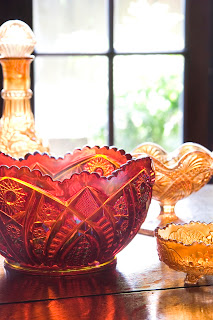What was once considered a second-rate offering becomes one of today’s top collectibles.
When the Fenton Art Glass Company started producing their Iridill glass collection circa 1908, they expected a wave of interest from consumers. Iridill was an eye-catching style for sure with its iridescent finish over jewel-tone pressed glass. The makers hoped to entice collectors of Tiffany and Steuben glass who were drawn to the shiny textural finishes. However, the consumer rush never materialized and the line was dubbed a dud, discounted and shipped off to secondary sellers.
It wasn’t until the large quantities of Iridill, now considered cheap and plentiful, began being used as carnival prizes that they became widely beloved, and dubbed Carnival Glass.
• The iridescent finish on Carnival Glass is created by applying metallic salts to the hot surface of the newly pressed glass. A second firing then distributes and amplifies the iridescent qualities.
• Pieces with heavy, even iridescences are valued higher than those with weak silvery finishes.
• Fenton and Northwood were two prolific manufacturers of Carnival Glass. However, manufacturers, including the aforementioned, often didn’t include markings, and today it does not affect the value of the piece.
• The color of Carnival Glass is determined by the glass color, not the iridescence color. Marigold (pictured in the darker shade, pumpkin, and the standard pastel) was the first and most popular early color. It was created by spraying an orange finish on clear glass. To help determine the glass color, check the bottom, or footing, of the piece to find an unfired section. This is also a good indication of original 1920s-1930s Carnival Glass, as the bottoms were never iridized.
• While eBay is the most accessible way to search for Carnival glass, it’s often better to find venues where you can examine a piece in person. Because of its iridescence, Carnival Glass is hard to photograph, and it’s difficult to assess the true condition, color and finish without seeing the item in person. Of course, there are accredited sources online such as Carnival Glass authority David Doty’s site ddoty.com. For a comprehensive list of Carnival Glass auctions and conventions where you can find trusted dealers, visit the International Carnival Glass Association Web site at international carnival glass.com.
When the Fenton Art Glass Company started producing their Iridill glass collection circa 1908, they expected a wave of interest from consumers. Iridill was an eye-catching style for sure with its iridescent finish over jewel-tone pressed glass. The makers hoped to entice collectors of Tiffany and Steuben glass who were drawn to the shiny textural finishes. However, the consumer rush never materialized and the line was dubbed a dud, discounted and shipped off to secondary sellers.
It wasn’t until the large quantities of Iridill, now considered cheap and plentiful, began being used as carnival prizes that they became widely beloved, and dubbed Carnival Glass.
• The iridescent finish on Carnival Glass is created by applying metallic salts to the hot surface of the newly pressed glass. A second firing then distributes and amplifies the iridescent qualities.
• Pieces with heavy, even iridescences are valued higher than those with weak silvery finishes.
• Fenton and Northwood were two prolific manufacturers of Carnival Glass. However, manufacturers, including the aforementioned, often didn’t include markings, and today it does not affect the value of the piece.
• The color of Carnival Glass is determined by the glass color, not the iridescence color. Marigold (pictured in the darker shade, pumpkin, and the standard pastel) was the first and most popular early color. It was created by spraying an orange finish on clear glass. To help determine the glass color, check the bottom, or footing, of the piece to find an unfired section. This is also a good indication of original 1920s-1930s Carnival Glass, as the bottoms were never iridized.
• While eBay is the most accessible way to search for Carnival glass, it’s often better to find venues where you can examine a piece in person. Because of its iridescence, Carnival Glass is hard to photograph, and it’s difficult to assess the true condition, color and finish without seeing the item in person. Of course, there are accredited sources online such as Carnival Glass authority David Doty’s site ddoty.com. For a comprehensive list of Carnival Glass auctions and conventions where you can find trusted dealers, visit the International Carnival Glass Association Web site at international carnival glass.com.
